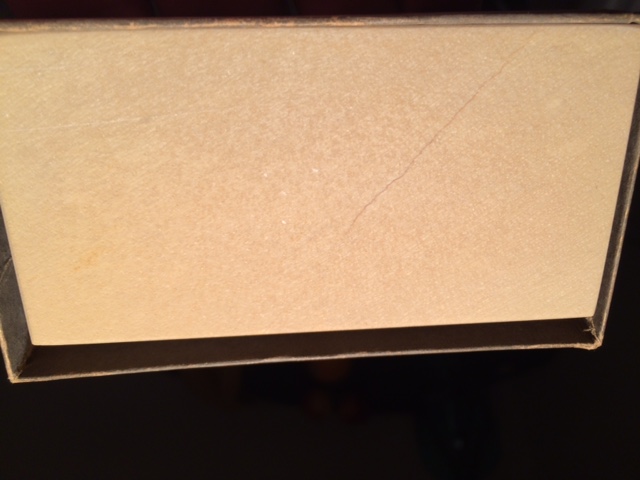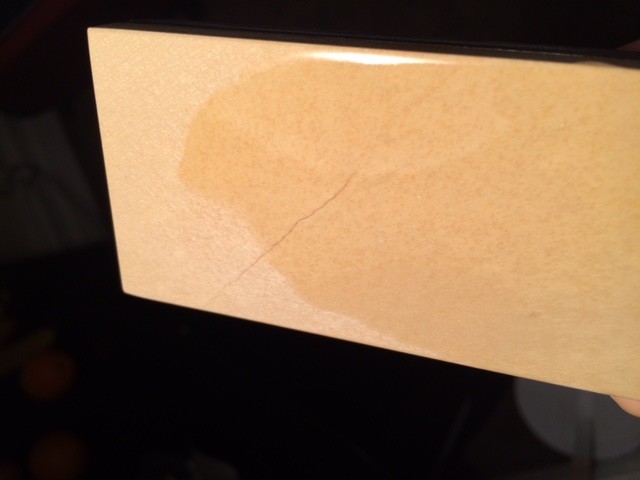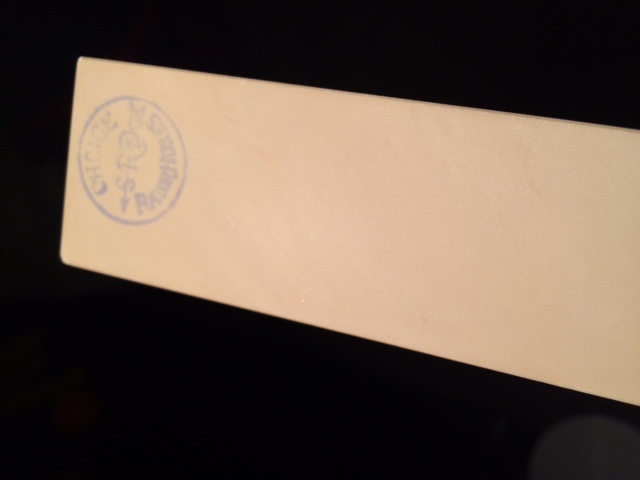Results 11 to 20 of 25
Thread: Should I lap or not?
-
09-27-2015, 03:09 AM #11

Bob, I've often wondered about honing in the past, after seeing severely dished and uneven stones. When I used the stone yesterday the edge made good contact with the stone at all times, and the result was exactly the reason I bought the stone in the first place. It should be noted that 95% of my razors are old and warped - so rolling x is really the only way I hone.
It can't be seen so well in the second last photo, but the stone is actually much more dished than the photo shows. This is/was a well used hone.
My real problem is that I'd like to use slurry on the stone, and so if I do it will only become worse.I love the smell of shaving cream in the morning!
-
09-27-2015, 03:23 AM #12Senior Member


- Join Date
- Apr 2008
- Location
- Saint Paul, Minnesota, United States
- Posts
- 2,944
Thanked: 433
save one end or the other, I did that with one of my stamped Coticules. It was easy for me as I only had the round stamp left
-
The Following User Says Thank You to rodb For This Useful Post:
Frankenstein (09-27-2015)
-
09-27-2015, 03:29 AM #13
-
The Following User Says Thank You to Phrank For This Useful Post:
Frankenstein (09-27-2015)
-
09-27-2015, 03:34 AM #14Senior Member

- Join Date
- Aug 2013
- Location
- NYC, NY
- Posts
- 1,497
Thanked: 169
Probably can get away with more dish with cotis because of the one stone honing deal. It becomes a nasty issue when you have a progression and each rock is out of true in different ways. Or a really hard rock with waves is bad news.
-
The Following User Says Thank You to kcb5150 For This Useful Post:
Frankenstein (09-27-2015)
-
09-27-2015, 03:36 AM #15Senior Member

- Join Date
- Aug 2013
- Location
- NYC, NY
- Posts
- 1,497
Thanked: 169
I didn't bother lapping the choice belgian I got last year with the stamp as it was near enough for me to rather have the stamp for now as I lacked the box and wanted to give the stone a proper shakedown first. It didn't cause any issues for me. I did lap a huge stamped one I got a couple of weeks ago though as it was out enough to be an annoyance with a wide stone.
-
09-27-2015, 04:35 AM #16

Since we are talking about the issue of stamps relevant to collectibility here, I'm happy to explain my position on it. This is the most expensive coti I have ever bought, but not by far. I have had two of the same brand before - one I got off another member, (for I think almost the same price), and one I bought a few months ago (it was about $50). The one from another member was an outstanding hone, but circumstances forced me to sell it. The other, which is also good, had a crack or something on it. So I bought this for three reasons - one, it was late at night and I was sitting at home alone with a bottle of wine, two, I am familiar with the brand and quality of the stone, and three, for me, two of the most interesting aspects of our hobby are honing and the history/historicity of the implements we use. I was genuinely interested to see what SRD considered a 'Choice Grade' hone, and while I don't have much experience with this one yet, so far I think SRD knew what he was talking about.
Of interest, last night I was pondering this subject, and thinking someone would bring up whether it was worth it. In my case, a good coticule cost me about $1500US - Price Breakdown: lack of experience $$$, not being able to trust sellers $$$, postage costs $$$, mistakes $$$, 9 or 10 other cotis, and then the price of the good one.
And is it worth it? In my case, after about 7 or 8 years of using a razor, I probably enjoy it more now than when I first started.Last edited by Frankenstein; 09-27-2015 at 08:13 AM.
I love the smell of shaving cream in the morning!
-
09-27-2015, 08:28 AM #17

Thank you for you point of view. Me, I am just not too sure in a gradation of coticules in general, that's all. I think most coticules that were sold in the past and are sold today for the purpose of razor honing will be quality hones, so the chance of getting a good one, with or without stamp, are relatively high anyway. The stamp and box mean that at some point either manufacturer or retailer considered the coticule good enough to be used on razors. Which is another sign that it probably will work just fine, but in my opinion not really all that relevant.
Even nowadays there is the distinction between the select and standard grades, which by Ardennes own admission is based purely on visuals, not performance. Some people feel there is a quite distinct difference in what you can expect from standard VS select. Personally, I have never noticed such a difference and would recommend standard grade coticules bouts to people looking to buy a new production coticule simply because they are the cheapest option. Generally speaking, standard grade coticules tend to look prettier too, I think
From what I understand, kosher coticules may be an exception as these were (are?) graded on speed as well as visual aspects. But I have not delved very deep into that specific aspect.
I still wonder what people mean by bad coticules and how one is to establish that a specific coticule is an inferior specimen. You mention you bought 9-10 other coticules before finding 'the good one'. Would you care to elaborate on why you considered the other ones bad and how you established that? I have one with hard mineral inclusions, so I consider that one bad, at least for razors. Apart from that and two coticules from "La Veine aux Clous" Bart Torfs mentioned that were extremely soft and extremely slow - yet still could be made to work for honing, but apparently prohibitively laboriously - I have trouble imagining a really bad (let alone basically useless) coticule and am genuinely interested in what you consider one, as it is a to me a quite foreign perspective. Which is interesting.Last edited by Pithor; 09-27-2015 at 08:34 AM. Reason: Formatting, dear Lord.
-
09-27-2015, 09:52 AM #18

I'll put a caveat first: With full hollow/hollow ground razors I think the type of coti is far less important. But with heavier blades, I notice quite a serious difference between stones. Perhaps that's just me, a lack of understanding or skill on my part, the way I use them, the mood I'm in, or some other unknown factor.
I can really only say what other more serious coticule users have said. And just to be clear, I'm not really a serious coticule user, lol. I use nanis and finish on a G20 or Barbers Delight most of the time. But my first hone was a coticule, and since then I've had a fascination with them, most probably because a couple of the best edges I've ever tried were off coticules, and well, I don't know, but there's just something about them that interests me. I arrived at my conclusions by frustrating trial and error, and by honing up old practise razors to see what the results were.
So to answer your question, some coticules are fast - and some are very very fast in removing steel. (Slurry will be dark grey in about 10-20 strokes). The one I have like that is a new one from Ardennes. It makes a good one stone hone, but I find the finish a little prickly so have to finish on another. (Of note, the BBW on the other side is by far the best bbw I've come across - I have more times than not used it as the finisher when using that stone.)
Some are slow to average in every respect. Slow can mean 200-300 circles before slurry changes colour. For these ones I don't find anything at all special about them - I may as well use a random stone found on the street. And the only way to get a decent edge off them is with technique and patience. To get an acceptable finish I need an extra layer of tape, or lather/soap, or oil finish, and even then it's nothing special. I'd rather just finish on a nani 8k and put more effort into stropping.
About a year ago I finally got a good one. Not long after I had to leave the country and the stone, but I did have the chance to use it a couple of times, which is nowhere near the amount of time you need to learn your stone. But that stone provided the type of edge I was looking for.
I'm hoping the current stone will do as well or better.
There's an interesting video on Youtube which I've just tried to find but can't. In it, the person has about 5 or 6 cotis and compares the different sound the razor makes while on them. I think it gives a good indication of the different qualities of some of these stones.
We can see a difference here:
This is a little vintage Rose Rock coti:


Here's the one I got yesterday.


We can see (with my phone camera you can't really see anything at all, lol) but there's a big difference in appearance. The former is a little wishy-washy, the latter is like a creme version of a good red wine. Peer into it and it looks like you could see the mysteries of the universe.
I'm not sure if I answered your question, but to sum up - some are good in the earlier stages of honing, others aren't very good at all, some are good as general stones (but inadequate compared to our modern synthetics), some are good in the latter stages of honing, and occasionally you'll find one that equals a good Thuringian - leaving a 'cute' but very precise edge.

Last edited by Frankenstein; 09-27-2015 at 10:00 AM.
I love the smell of shaving cream in the morning!
-
10-02-2015, 08:55 AM #19

That stone will only dish worse resulting in ruined razors. I would recommend that you take some pictures and then donate it to charity.
PM me and I will send you Charity's address...
-
10-03-2015, 03:10 PM #20

Pithor, you of course are an expert in cotis. All those posts on coti.be are testament to that. So, most of yours are new, right? I could never understand why people have a variety of new coticules. If you're saying they're all the same, why have so many?
Here's an interesting post by Neil Miller:
I don't have that much experience with collecting Eschers. But they grade their stones. Surely it stands that as the rock structure varies so too does the finish it leaves.I love the smell of shaving cream in the morning!


 31Likes
31Likes LinkBack URL
LinkBack URL About LinkBacks
About LinkBacks







 Reply With Quote
Reply With Quote


